window HYUNDAI KONA EV 2022 Owners Manual
[x] Cancel search | Manufacturer: HYUNDAI, Model Year: 2022, Model line: KONA EV, Model: HYUNDAI KONA EV 2022Pages: 548, PDF Size: 49.14 MB
Page 39 of 548

Foreword / Electric Vehicle System Overview
1-34
à Example for setting the ICCB charge level
The example is only for reference and may vary according to the surrounding
environment.
Outlet current ICCB charge level Control box display window
14-16A 12A
OOSEVQ018055
13-12A
10A
11-10A 8A
CAUTION
Please make sure that charge level selection matches the capacity of your circuit
breaker to avoid blown fuse.
Page 63 of 548
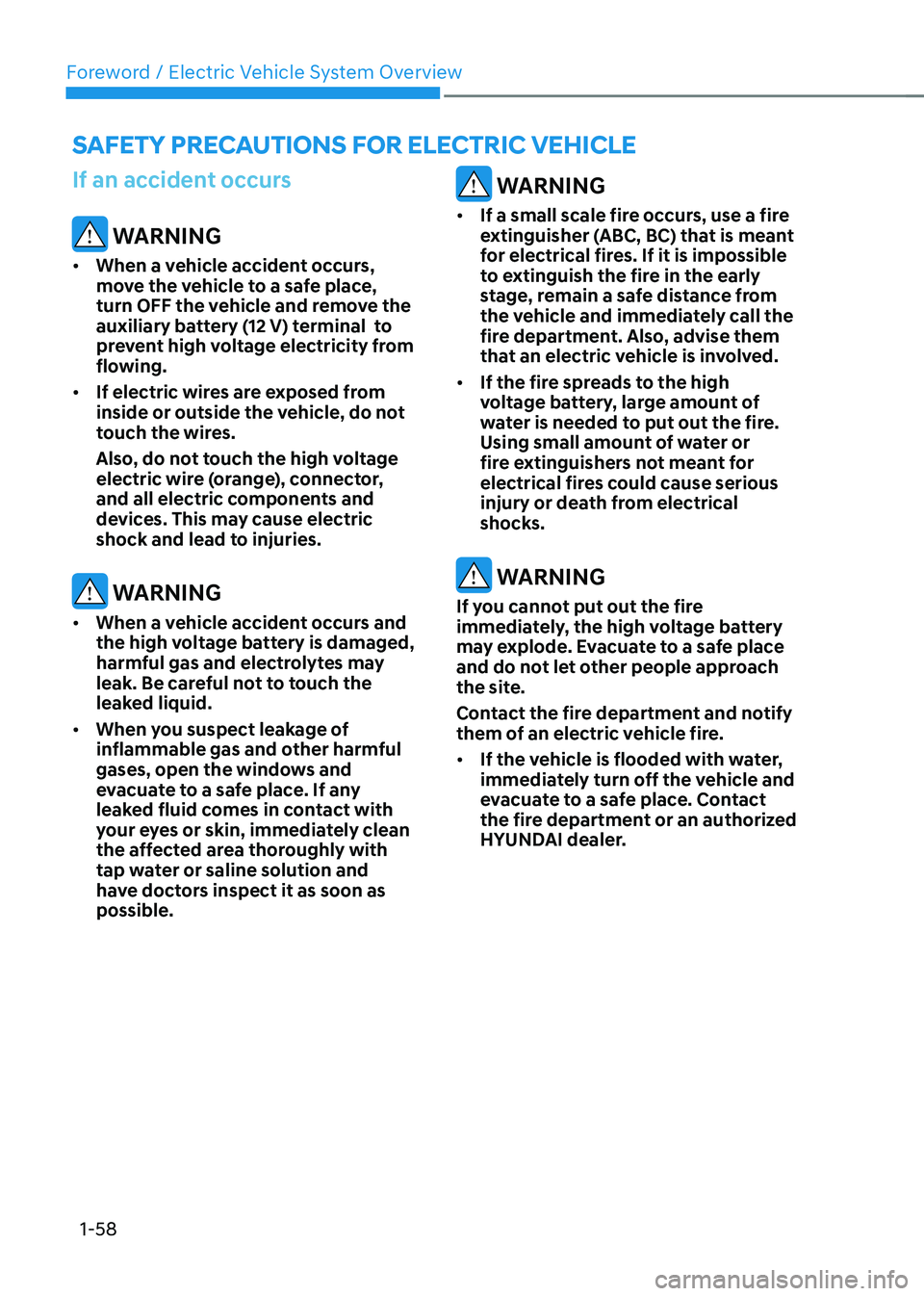
Foreword / Electric Vehicle System Overview
1-58
If an accident occurs
WARNING
• When a vehicle accident occurs,
move the vehicle to a safe place,
turn OFF the vehicle and remove the
auxiliary battery (12 V) terminal to
prevent high voltage electricity from
flowing.
• If electric wires are exposed from
inside or outside the vehicle, do not
touch the wires.
Also, do not touch the high voltage
electric wire (orange), connector,
and all electric components and
devices. This may cause electric
shock and lead to injuries.
WARNING
• When a vehicle accident occurs and
the high voltage battery is damaged,
harmful gas and electrolytes may
leak. Be careful not to touch the
leaked liquid.
• When you suspect leakage of
inflammable gas and other harmful
gases, open the windows and
evacuate to a safe place. If any
leaked fluid comes in contact with
your eyes or skin, immediately clean
the affected area thoroughly with
tap water or saline solution and
have doctors inspect it as soon as possible.
WARNING
• If a small scale fire occurs, use a fire
extinguisher (ABC, BC) that is meant
for electrical fires. If it is impossible
to extinguish the fire in the early
stage, remain a safe distance from
the vehicle and immediately call the
fire department. Also, advise them
that an electric vehicle is involved.
• If the fire spreads to the high
voltage battery, large amount of
water is needed to put out the fire.
Using small amount of water or
fire extinguishers not meant for
electrical fires could cause serious
injury or death from electrical
shocks.
WARNING
If you cannot put out the fire
immediately, the high voltage battery
may explode. Evacuate to a safe place
and do not let other people approach
the site.
Contact the fire department and notify
them of an electric vehicle fire. • If the vehicle is flooded with water,
immediately turn off the vehicle and
evacuate to a safe place. Contact
the fire department or an authorized
HYUNDAI dealer.
saFeTy preCauTions For eleCTriC VeHiCle
Page 67 of 548
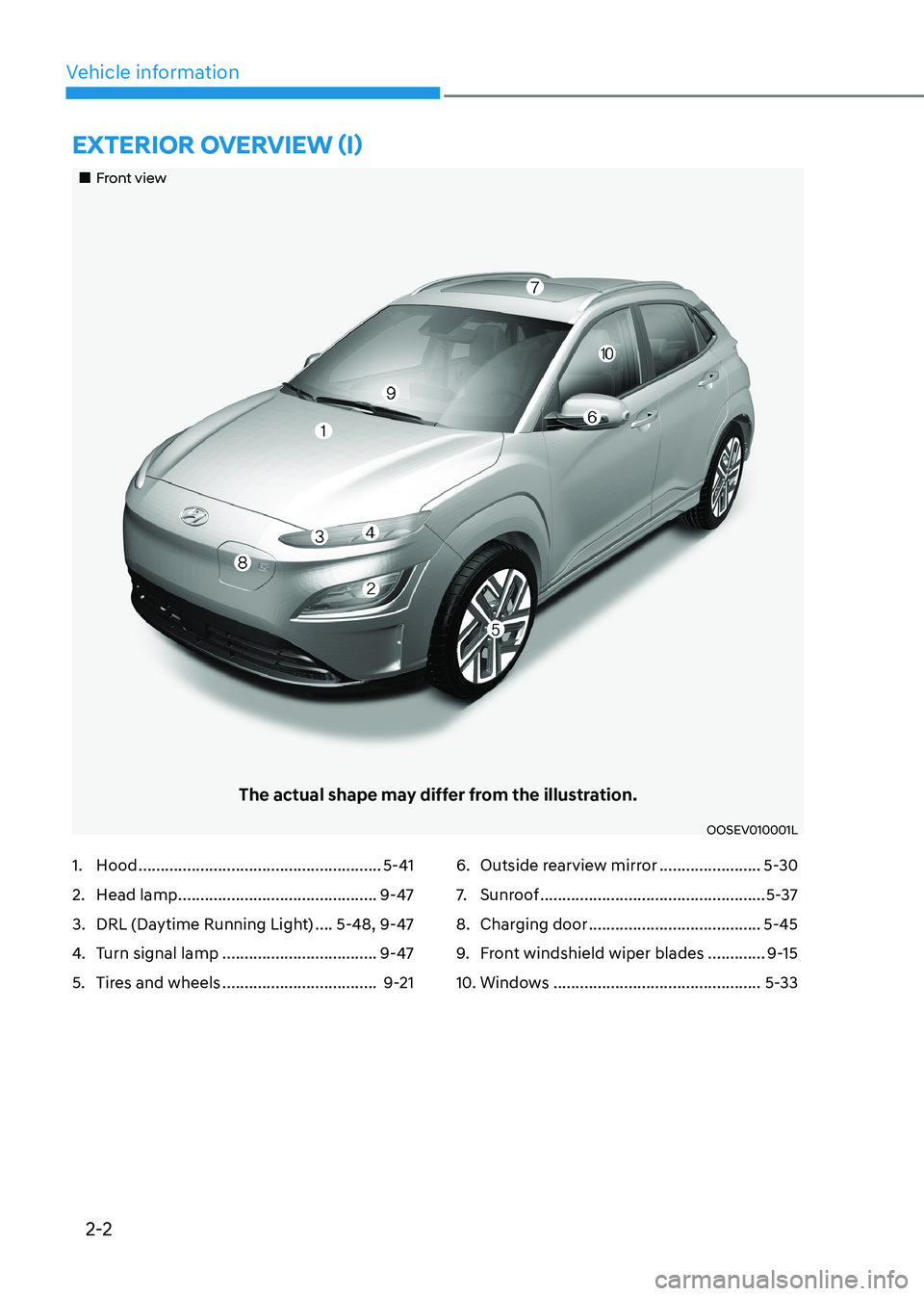
2-2
Vehicle informationExtErior ovErviEw (i)
„„Front view
The actual shape may differ from the illustration.
OOSEV010001L
1. Hood ....................................................... 5-41
2. Head lamp ............................................. 9-47
3. DRL (Daytime Running Light) ....5-48, 9-47
4. Turn signal lamp ................................... 9-47
5. Tires and wheels ................................... 9-216. Outside rearview mirror
.......................5-30
7. Sunroof ................................................... 5-37
8. Charging door ....................................... 5-45
9. Front windshield wiper blades .............9-15
10. Windows ............................................... 5-33
Page 68 of 548
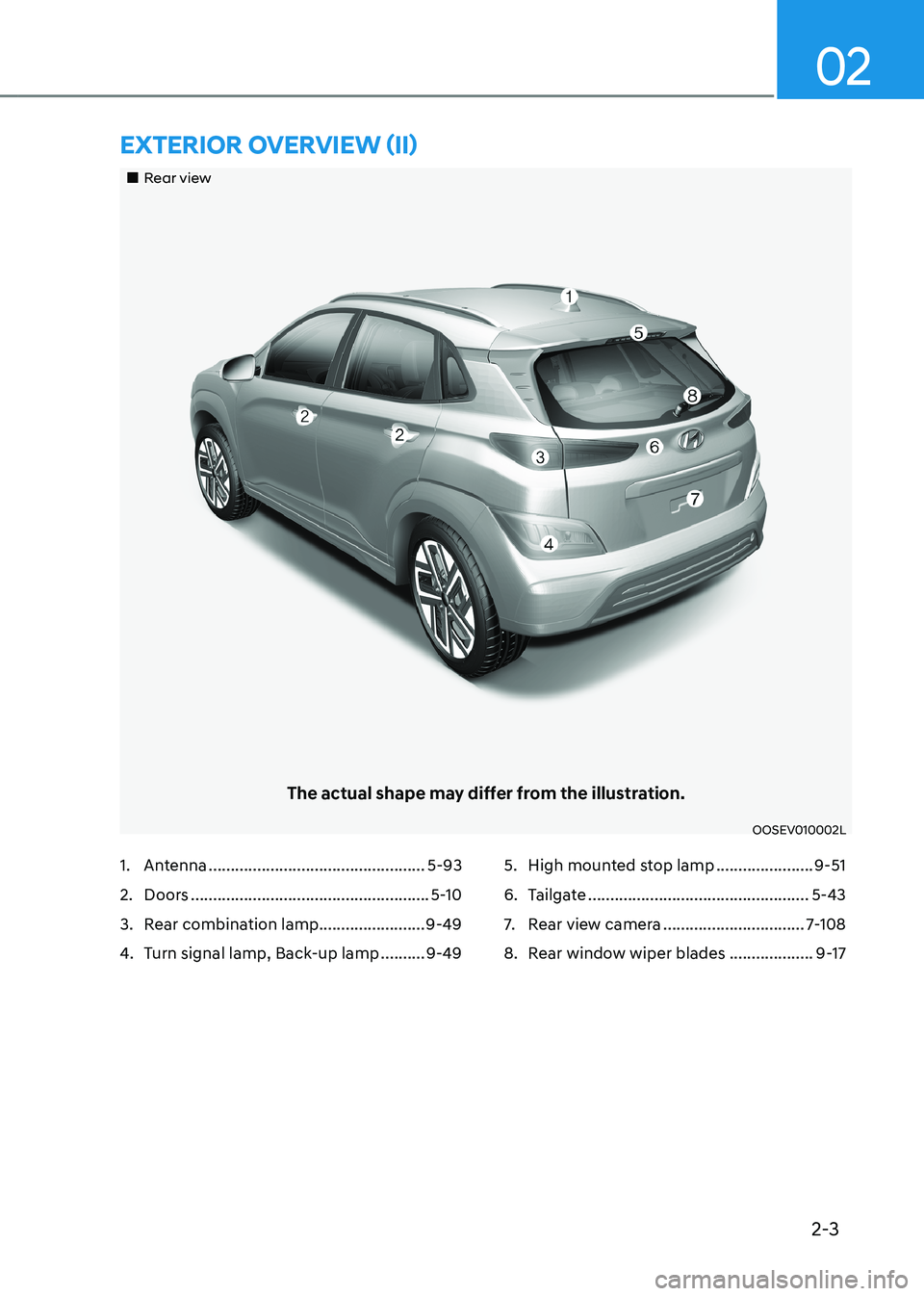
2-3
02
„„Rear view
The actual shape may differ from the illustration.
OOSEV010002L
ExtErior ovErviEw (ii)
1. Antenna ................................................. 5-93
2. Doors ...................................................... 5-10
3. Rear combination lamp........................ 9-49
4. Turn signal lamp, Back-up lamp ..........9-49 5. High mounted stop lamp
......................9-51
6. Tailgate .................................................. 5-43
7. Rear view camera ................................ 7-108
8. Rear window wiper blades ...................9-17
Page 69 of 548
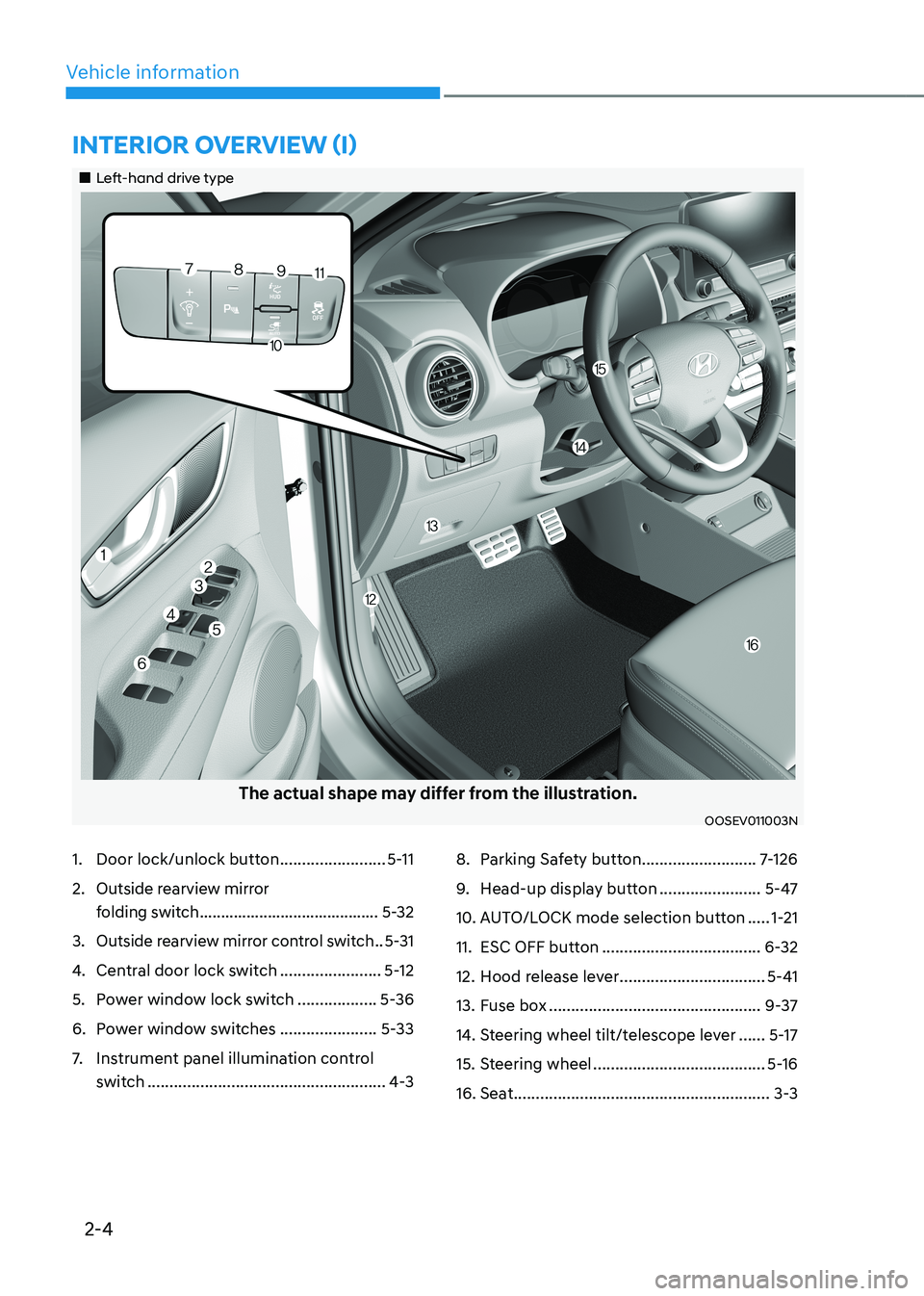
2-4
Vehicle information
1. Door lock/unlock button ........................5-11
2. Outside rearview mirror
folding switch .......................................... 5-32
3. Outside rearview mirror control switch ..5-31
4. Central door lock switch .......................5-12
5. Power window lock switch ..................5-36
6. Power window switches ......................5-33
7. Instrument panel illumination control
switch ...................................................... 4-38. Parking Safety button
..........................7-126
9. Head-up display button .......................5-47
10. AUTO/LOCK mode selection button .....1-21
11. ESC OFF button .................................... 6-32
12. Hood release lever .................................5-41
13. Fuse box ................................................ 9-37
14. Steering wheel tilt/telescope lever ......5-17
15. Steering wheel ....................................... 5-16
16. Seat .......................................................... 3-3
intErior ovErviEw (i)
„„Left-hand drive type
The actual shape may differ from the illustration.
OOSEV011003N
Page 125 of 548
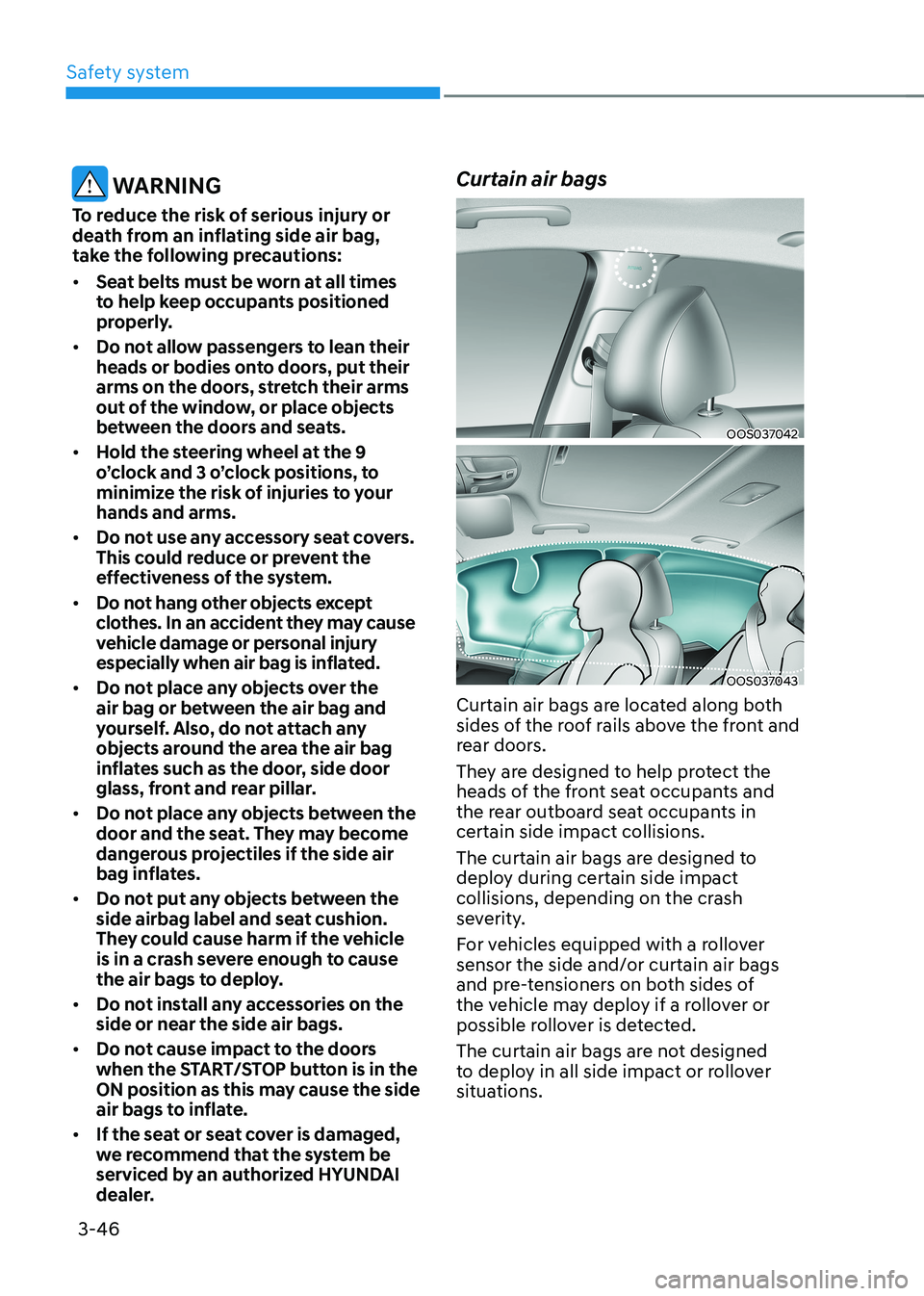
Safety system
3-46
WARNING
To reduce the risk of serious injury or
death from an inflating side air bag,
take the following precautions: • Seat belts must be worn at all times
to help keep occupants positioned
properly.
• Do not allow passengers to lean their
heads or bodies onto doors, put their
arms on the doors, stretch their arms
out of the window, or place objects
between the doors and seats.
• Hold the steering wheel at the 9
o’clock and 3 o’clock positions, to
minimize the risk of injuries to your hands and arms.
• Do not use any accessory seat covers.
This could reduce or prevent the
effectiveness of the system.
• Do not hang other objects except
clothes. In an accident they may cause
vehicle damage or personal injury
especially when air bag is inflated.
• Do not place any objects over the
air bag or between the air bag and
yourself. Also, do not attach any
objects around the area the air bag
inflates such as the door, side door
glass, front and rear pillar.
• Do not place any objects between the
door and the seat. They may become
dangerous projectiles if the side air
bag inflates.
• Do not put any objects between the
side airbag label and seat cushion.
They could cause harm if the vehicle
is in a crash severe enough to cause
the air bags to deploy.
• Do not install any accessories on the side or near the side air bags.
• Do not cause impact to the doors
when the START/STOP button is in the
ON position as this may cause the side
air bags to inflate.
• If the seat or seat cover is damaged,
we recommend that the system be
serviced by an authorized HYUNDAI
dealer. Curtain air bags
OOS037042
OOS037043
Curtain air bags are located along both
sides of the roof rails above the front and
rear doors.
They are designed to help protect the
heads of the front seat occupants and
the rear outboard seat occupants in certain side impact collisions.
The curtain air bags are designed to
deploy during certain side impact
collisions, depending on the crash
severity.
For vehicles equipped with a rollover sensor the side and/or curtain air bags
and pre-tensioners on both sides of
the vehicle may deploy if a rollover or
possible rollover is detected.
The curtain air bags are not designed
to deploy in all side impact or rollover
situations.
Page 126 of 548
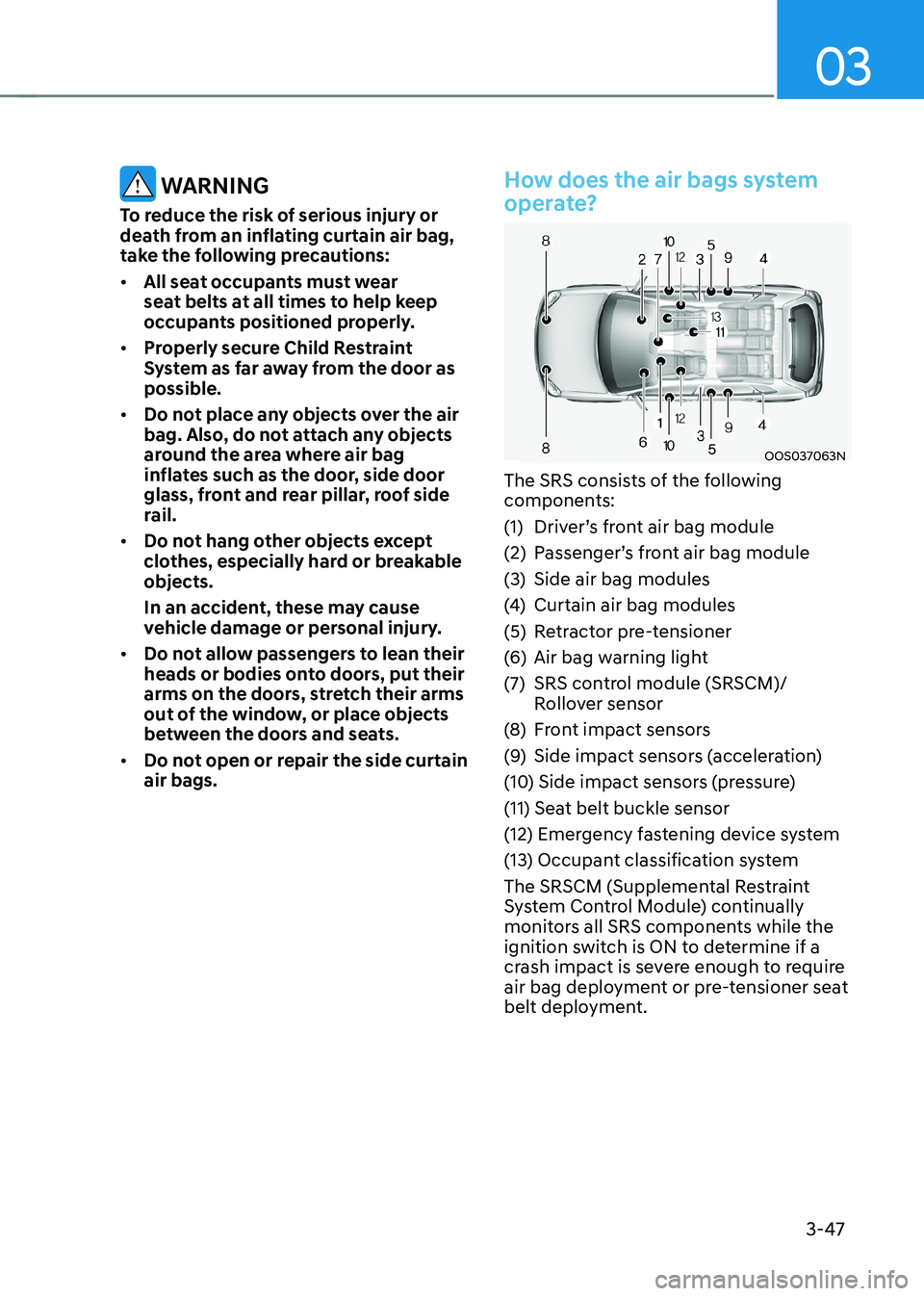
03
3-47
WARNING
To reduce the risk of serious injury or
death from an inflating curtain air bag,
take the following precautions: • All seat occupants must wear
seat belts at all times to help keep
occupants positioned properly.
• Properly secure Child Restraint
System as far away from the door as possible.
• Do not place any objects over the air
bag. Also, do not attach any objects
around the area where air bag
inflates such as the door, side door
glass, front and rear pillar, roof side
rail.
• Do not hang other objects except
clothes, especially hard or breakable objects.
In an accident, these may cause
vehicle damage or personal injury.
• Do not allow passengers to lean their
heads or bodies onto doors, put their
arms on the doors, stretch their arms
out of the window, or place objects
between the doors and seats.
• Do not open or repair the side curtain air bags.How does the air bags system
operate?
OOS037063N
The SRS consists of the following
components:
(1) Driver’s front air bag module
(2) Passenger’s front air bag module
(3) Side air bag modules
(4) Curtain air bag modules
(5) Retractor pre-tensioner
(6) Air bag warning light
(7) SRS control module (SRSCM)/ Rollover sensor
(8) Front impact sensors
(9) Side impact sensors (acceleration)
(10) Side impact sensors (pressure)
(11) Seat belt buckle sensor
(12) Emergency fastening device system
(13) Occupant classification system
The SRSCM (Supplemental Restraint
System Control Module) continually
monitors all SRS components while the
ignition switch is ON to determine if a
crash impact is severe enough to require
air bag deployment or pre-tensioner seat
belt deployment.
Page 130 of 548
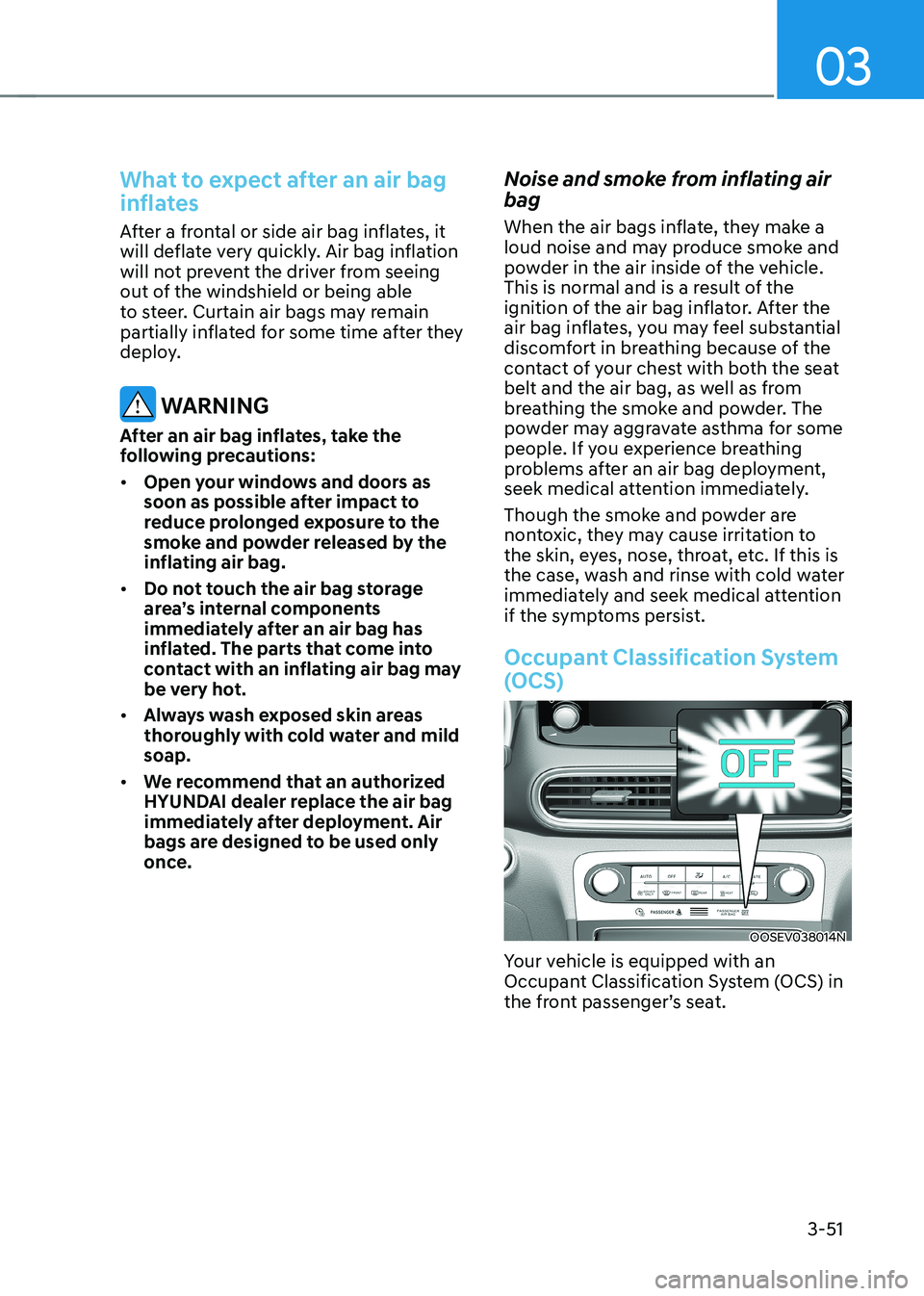
03
3-51
What to expect after an air bag
inflates
After a frontal or side air bag inflates, it
will deflate very quickly. Air bag inflation
will not prevent the driver from seeing
out of the windshield or being able
to steer. Curtain air bags may remain
partially inflated for some time after they
deploy.
WARNING
After an air bag inflates, take the
following precautions: • Open your windows and doors as
soon as possible after impact to
reduce prolonged exposure to the
smoke and powder released by the
inflating air bag.
• Do not touch the air bag storage
area’s internal components
immediately after an air bag has
inflated. The parts that come into
contact with an inflating air bag may
be very hot.
• Always wash exposed skin areas
thoroughly with cold water and mild soap.
• We recommend that an authorized
HYUNDAI dealer replace the air bag
immediately after deployment. Air
bags are designed to be used only
once. Noise and smoke from inflating air bag
When the air bags inflate, they make a
loud noise and may produce smoke and
powder in the air inside of the vehicle.
This is normal and is a result of the
ignition of the air bag inflator. After the
air bag inflates, you may feel substantial
discomfort in breathing because of the
contact of your chest with both the seat
belt and the air bag, as well as from
breathing the smoke and powder. The
powder may aggravate asthma for some
people. If you experience breathing
problems after an air bag deployment,
seek medical attention immediately.
Though the smoke and powder are
nontoxic, they may cause irritation to
the skin, eyes, nose, throat, etc. If this is
the case, wash and rinse with cold water
immediately and seek medical attention
if the symptoms persist.
Occupant Classification System
(OCS)
OOSEV038014N
Your vehicle is equipped with an
Occupant Classification System (OCS) in
the front passenger’s seat.
Page 185 of 548
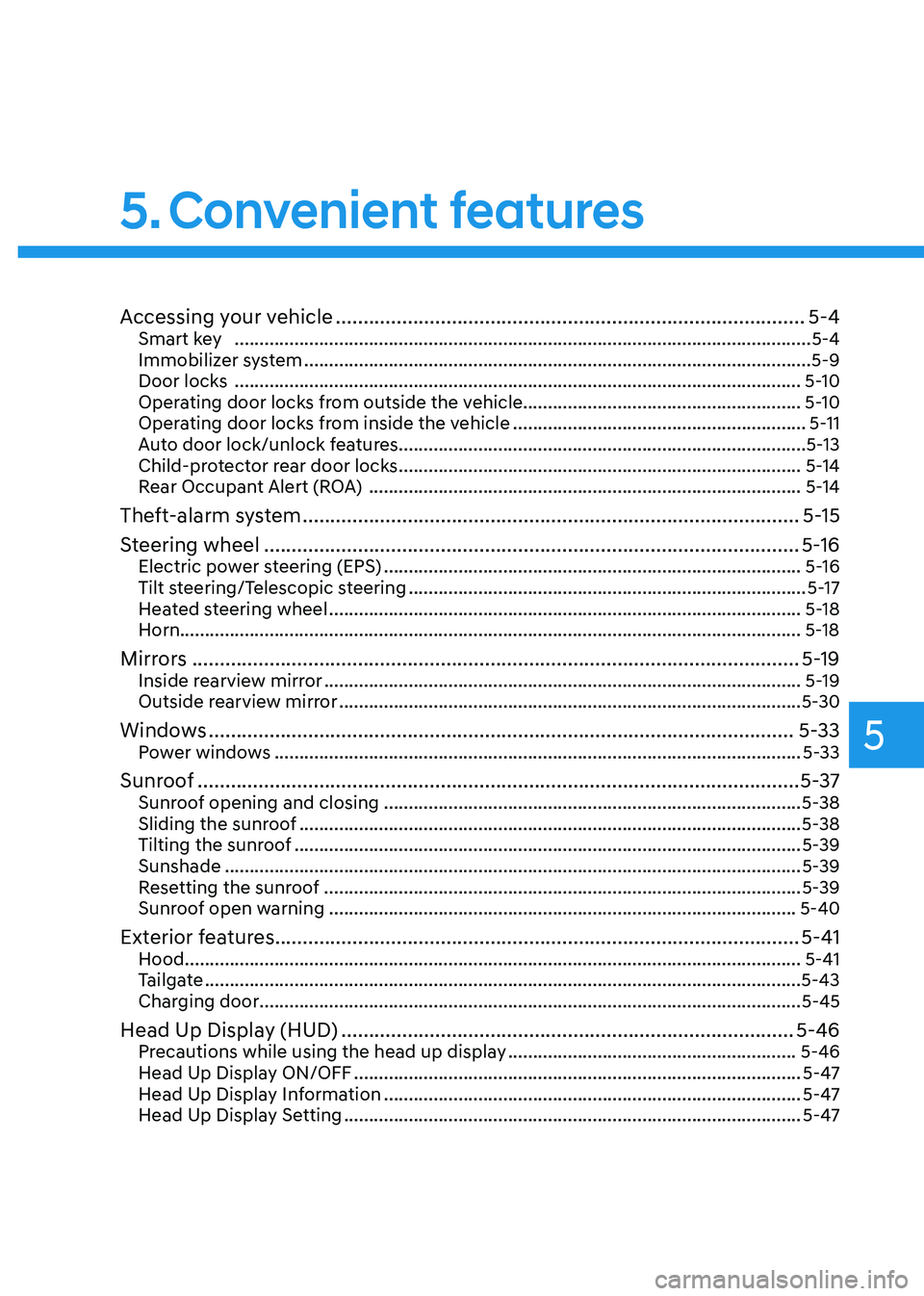
5
Accessing your vehicle ..................................................................................... 5-4
Smart key .................................................................................................................... 5-4
Immobilizer system ...................................................................................................... 5-9
Door locks .................................................................................................................. 5-10
Operating door locks from outside the vehicle........................................................ 5-10
Operating door locks from inside the vehicle ...........................................................5-11
Auto door lock/unlock features..................................................................................5-13
Child-protector rear door locks ................................................................................. 5-14
Rear Occupant Alert (ROA) ....................................................................................... 5-14
Theft-alarm system .......................................................................................... 5-15
Steering wheel ................................................................................................. 5-16
Electric power steering (EPS) .................................................................................... 5-16
Tilt steering/Telescopic steering ................................................................................ 5-17
Heated steering wheel ............................................................................................... 5-18
Horn............................................................................................................................. 5-18
Mirrors .............................................................................................................. 5-19
Inside rearview mirror ................................................................................................ 5-19
Outside rearview mirror ............................................................................................. 5-30
Windows .......................................................................................................... 5-33
Power windows .......................................................................................................... 5-33
Sunroof ............................................................................................................. 5-37
Sunroof opening and closing .................................................................................... 5-38
Sliding the sunroof ..................................................................................................... 5-38
Tilting the sunroof ...................................................................................................... 5-39
Sunshade .................................................................................................................... 5-39
Resetting the sunroof ................................................................................................ 5-39
Sunroof open warning .............................................................................................. 5-40
Exterior features ............................................................................................... 5-41
Hood ............................................................................................................................ 5-41
Tailgate ........................................................................................................................ 5-43
Charging door ............................................................................................................. 5-45
Head Up Display (HUD) .................................................................................. 5-46
Precautions while using the head up display ..........................................................5-46
Head Up Display ON/OFF .......................................................................................... 5-47
Head Up Display Information .................................................................................... 5-47
Head Up Display Setting ............................................................................................ 5-47
5. Convenient features
Page 186 of 548
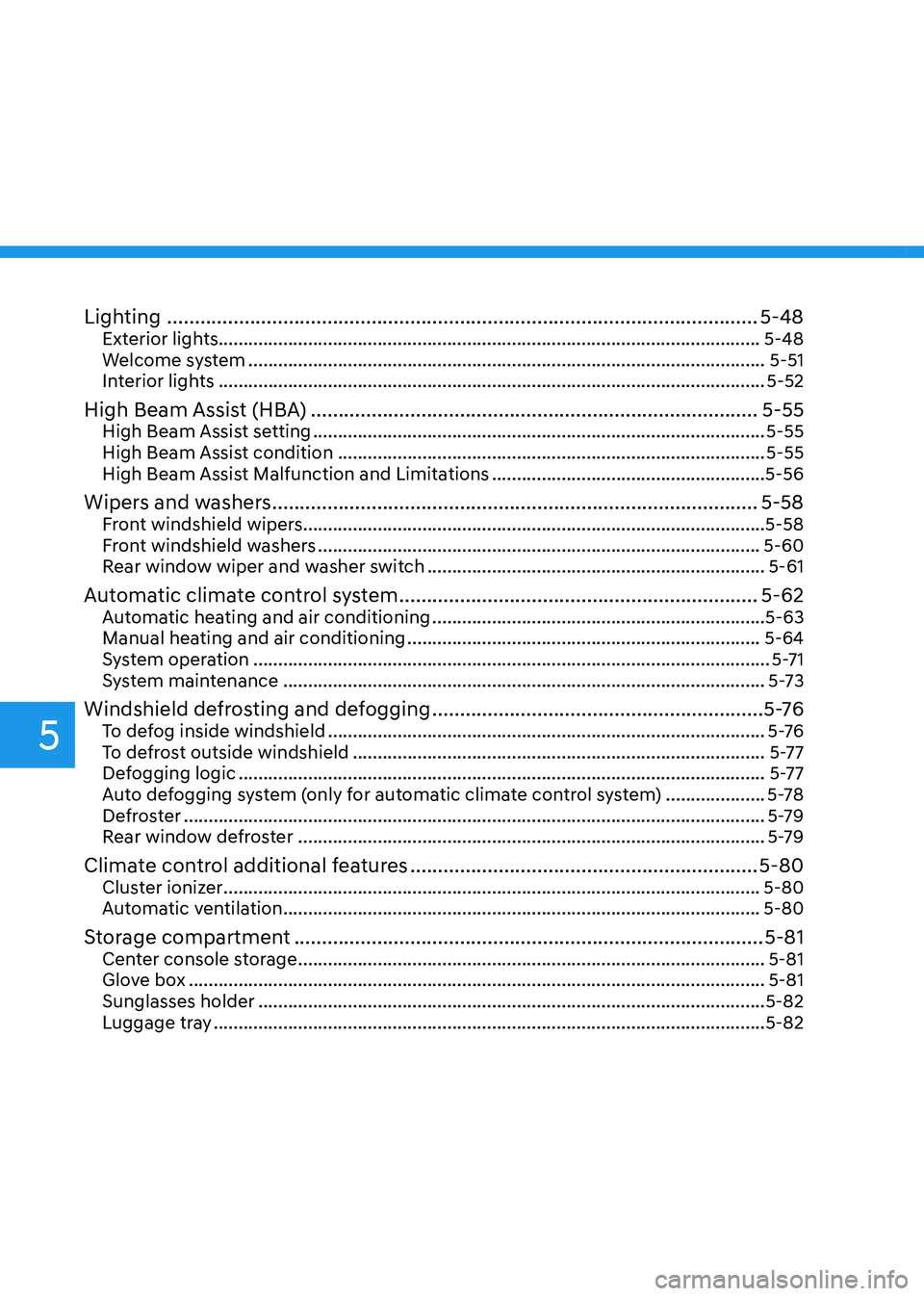
5
Lighting ........................................................................................................... 5-48
Exterior lights............................................................................................................. 5-48 Welcome system ........................................................................................................ 5-51
Interior lights .............................................................................................................. 5-52
High Beam Assist (HBA) ................................................................................. 5-55
High Beam Assist setting ........................................................................................... 5-55
High Beam Assist condition ...................................................................................... 5-55
High Beam Assist Malfunction and Limitations .......................................................5-56
Wipers and washers ........................................................................................ 5-58
Front windshield wipers ............................................................................................. 5-58
Front windshield washers ......................................................................................... 5-60
Rear window wiper and washer switch .................................................................... 5-61
Automatic climate control system ................................................................. 5-62
Automatic heating and air conditioning ................................................................... 5-63
Manual heating and air conditioning ....................................................................... 5-64
System operation ........................................................................................................ 5-71
System maintenance ................................................................................................. 5-73
Windshield defrosting and defogging ............................................................5 -76
To defog inside windshield ........................................................................................ 5 -76
To defrost outside windshield ................................................................................... 5-77
Defogging logic .......................................................................................................... 5-77
Auto defogging system (only for automatic climate control system) ....................5-78
Defroster ..................................................................................................................... 5-79
Rear window defroster .............................................................................................. 5-79
Climate control additional features ............................................................... 5-80
Cluster ionizer ............................................................................................................ 5-80
Automatic ventilation ................................................................................................ 5-80
Storage compartment ..................................................................................... 5-81
Center console storage .............................................................................................. 5-81
Glove box .................................................................................................................... 5-81
Sunglasses holder ...................................................................................................... 5-82
Luggage tray ............................................................................................................... 5-82